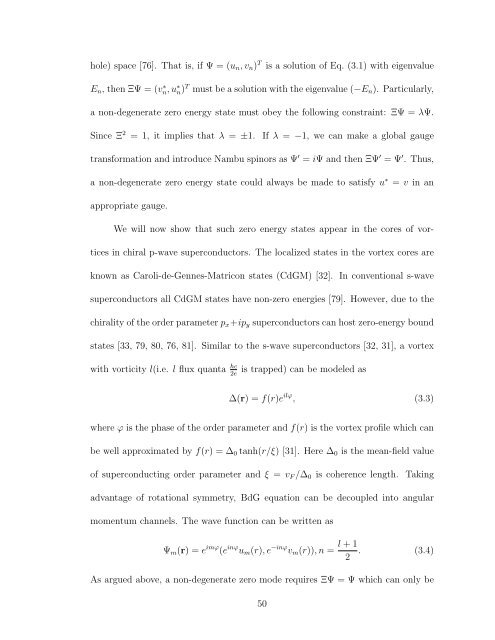ABSTRACT - DRUM - University of Maryland
ABSTRACT - DRUM - University of Maryland
ABSTRACT - DRUM - University of Maryland
You also want an ePaper? Increase the reach of your titles
YUMPU automatically turns print PDFs into web optimized ePapers that Google loves.
hole) space [76]. That is, if Ψ = (u n , v n ) T is a solution <strong>of</strong> Eq. (3.1) with eigenvalue<br />
E n , then ΞΨ = (v ∗ n, u ∗ n) T must be a solution with the eigenvalue (−E n ). Particularly,<br />
a non-degenerate zero energy state must obey the following constraint: ΞΨ = λΨ.<br />
Since Ξ 2 = 1, it implies that λ = ±1. If λ = −1, we can make a global gauge<br />
transformation and introduce Nambu spinors as Ψ ′ = iΨ and then ΞΨ ′ = Ψ ′ . Thus,<br />
a non-degenerate zero energy state could always be made to satisfy u ∗ = v in an<br />
appropriate gauge.<br />
We will now show that such zero energy states appear in the cores <strong>of</strong> vortices<br />
in chiral p-wave superconductors. The localized states in the vortex cores are<br />
known as Caroli-de-Gennes-Matricon states (CdGM) [32]. In conventional s-wave<br />
superconductors all CdGM states have non-zero energies [79]. However, due to the<br />
chirality <strong>of</strong> the order parameter p x +ip y superconductors can host zero-energy bound<br />
states [33, 79, 80, 76, 81]. Similar to the s-wave superconductors [32, 31], a vortex<br />
with vorticity l(i.e. l flux quanta hc<br />
2e<br />
is trapped) can be modeled as<br />
∆(r) = f(r)e ilϕ , (3.3)<br />
where ϕ is the phase <strong>of</strong> the order parameter and f(r) is the vortex pr<strong>of</strong>ile which can<br />
be well approximated by f(r) = ∆ 0 tanh(r/ξ) [31]. Here ∆ 0 is the mean-field value<br />
<strong>of</strong> superconducting order parameter and ξ = v F /∆ 0 is coherence length. Taking<br />
advantage <strong>of</strong> rotational symmetry, BdG equation can be decoupled into angular<br />
momentum channels. The wave function can be written as<br />
Ψ m (r) = e imϕ (e inϕ u m (r), e −inϕ v m (r)), n = l + 1<br />
2 . (3.4)<br />
As argued above, a non-degenerate zero mode requires ΞΨ = Ψ which can only be<br />
50
















